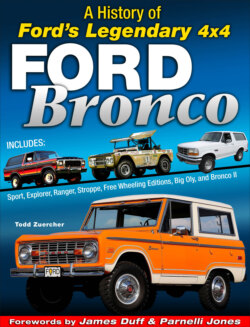Читать книгу Ford Bronco: A History of Ford's Legendary 4x4 - Todd Zuercher - Страница 25
На сайте Литреса книга снята с продажи.
Dana 30
ОглавлениеDana promised 500 pounds more capacity than the Dana 27 with the Dana 30 through the use of thicker walled, larger tubes. The 2,500-pound capacity rating fit neatly between the competition (2,000 pounds) and full-size pickups (Dana 44 with a 3,000-pound rating). More important, it featured the industry’s first open-knuckle design, which allowed much tighter turning angles than its closed-knuckle cousin (37 versus 29 degrees). Axelrad noted that the full advantage of the Bronco’s coil-spring front suspension could not be realized without the use of the open knuckles due to the steering angle limitations of the closed-knuckle design.
The 1966–1967 locking hubs were optional ($66.08), and they are unique to those years. In 1968, Ford switched to a bright housing with a red dial.
Because the open-knuckle design required new sealing and lubrication strategies, Ford did extensive laboratory and road testing of the new axle seals to ensure that they were satisfactory. Road testing in sand, dirt, and gravel took place in northwestern Arizona surrounding the Arizona Ford Proving Grounds in Yucca. As a result of this testing, some seals and bearings were modified before production began.
The Dana 30 proved to be a good first volley across the bow of competitors in terms of upgraded axles. It gave up just a bit of ground clearance (1 to 1.5 inches) to go along with the slightly increased housing size. Ford did consider using the high-pinion Dana 44 that was introduced in the 1966 Ford F-100, but driveshaft clearance problems precluded its adaptation. Front brakes were of the drum variety and measured 11x2 inches.
The testers’ impressions of the brakes were one area that showed how much perceptions and expectations of vehicle performance have changed since 1966. Nearly every test of the first Bronco praised the “large” brakes and their holding power, with some going so far as to exclaim that power brakes were not necessary because the existing setup was so strong and required such low pedal pressure. Those were the expectations in the mid-1960s. In just a few years, with power disc brakes much more prevalent on passenger cars, reviewers complained of fading, pulling, and excessively high pedal effort.
